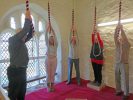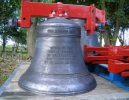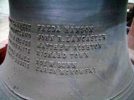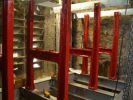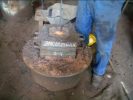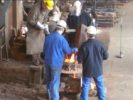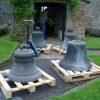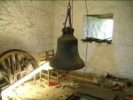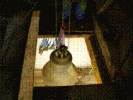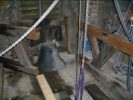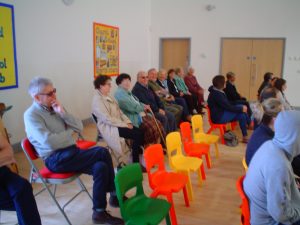Author Archive | leeds11
The Bells at St Mary-le-Ghyll Church
[slideshow_deploy id=’416′]
The original three bells, which have rung out over Barnoldswick since 1723, were cast and hung by Abraham Rudhall II. of Gloucester. In 1880, T. Mallaby and Sons, bellhangers of Masham, removed the bells for refurbishment. They were reinstalled in a new wooden frame and fittings in May, 1881.
These bells fell into disuse during the last quarter of the 20th Century. In 2005 repairs and maintenance were carried out on them and a new Ringing Band was formed from members of the congregation and from local inhabitants. It was soon realised that to maintain interest as the Band progressed, it would be advisable to augment the ring to six or eight bells.
A project to raise the necessary funds of £67,000 commenced in 2006. However, by 2009 sufficient funds had been raised and work done to augment to six bells in the interim period. Meanwhile fund raising continues and it is hoped to finish the project by the addition of the final two bells sometime in the future. Donations towards this are gratefully accepted and can be made to the Treasurer of the Ghyll Bells Group, Roy Bunn, tel. 01282 813703.
In November, 2009 the ring of six bells was installed in a cast iron frame which can accommodate eight bells. On 30 January 2010, the bells were dedicated by Rt. Revd. David James, Bishop of Bradford, in the presence of their Worships the Mayor and Mayoress of Pendle. Weekly bell ringing practice and instruction is held every Tuesday evening, from 7.30 p.m. to 9 p.m. and invitation is open to all (whether being existing bell ringers or potential learners) to join our ringing band. Enquiries relating to joining both as an existing bell ringer or to learn can be made to the Tower Captain, Chris Whale, tel. 01282 812734.
The three original bells of 1723 now form the 2nd, 3rd, and 4th of the ring.
- The 1st bell, known as the treble, originally cast by John Taylor of Loughborough, was acquired from among the redundant bells from St. George’s Church, Kendal in Cumbria.
- The 2nd bell is inscribed, “A.R. 1723. Peace and Good Neighbourhood”.
- The 3rd is inscribed, “Render therefore unto Caesar the things which are Caesar’s and unto God the things that are God’s. A.R. 1723”
- The 4th is inscribed, “Wm. Drake Esq. Ch. Warden. A.R. 1723”.
- The 5th bell, known as the Ringer’s Bell, was cast on the 3rd May 2007 to celebrate the church’s 850 anniversary, by Taylor, Eayre and Smith of Loughborough. It is inscribed with the names of the members of the Band at that time, some of whom made generous contributions to its cost.
- The 6th bell, the tenor, was cast in 2009 by Taylor, Eayre and Smith and is inscribed with a dedication to each of the Lancashire and Yorkshire Associations of Change Ringers, who were the major sponsors of the project.
Bell Weight Hz Note Diameter
cwts. qtrs. lbs.
- 1 3 2 24 1399.0 F 26.25”
- 2 4 0 16 1246.0 E flat 27.25”
- 3 4 3 0 1111.5 D flat 29.75”
- 4 5 1 6 1046.0 C 31.00”
- 5 8 1 4 932.0 B flat 34.75”
- 6 12 1 17 832.0 A flat 39.50”
Church School
We are very proud of our links with the ‘Church School’ and encourage you to find out more about the educational opportunities that the school can offer your children.
Church School telephone: 01282 813014
Alcoholics Anonymous
Alcoholics Anonymous: Thursday 7.00pm & Saturday at 2.00pm at Holy Trinity . Contact : 07783 078 562
Ghyll Bell Ringers
Ghyll Bell Ringers Practice night: Tuesday 7 30pm—9.00pm
Sing Hymns Old & New
Sing Hymns Old & New: Mondays at Holy Trinity at 7.00pm
you are very welcome
Baptisms and Weddings
Baptisms and Weddings by arrangement with the Vicar

Churchwardens
Holy Trinity:
Vacancy
Stuart Ballard 01282 816261
St Mary-le-Ghyll :
George McDowell: Home 01282 813699
St Michael’s Bracewell:
Valerie Corbridge: Home 01282 812344
Freda Pilkington: Home 01200 445370
Children in Church
At the moment, we don’t have a children’s programme for every single week at Holy Trinity. So, that’s why we have children’s activity bags available for children who join us for the morning worship. These are full of fun-filled activity/craft ideas. There are some small tables and chairs for the children to sit at or if they prefer they can work on their activities in their seats and even take them home to finish off later.
Café Church
Café Church is an alternative approach to worship. It’s still a church service but instead of sitting quietly in rows, we sit around tables, drink coffee, eat a few biscuits or buns and enjoy worship that is relaxed and accessible. We still sing songs, say prayers and so on but in a more interactive way. So, if you’re looking for a service that’s engaging for all of the family, then this is the service for you. It is held on the fourth Sunday of each month at Holy Trinity at 3.00pm.
Trinity TeaTime
Trinity TeaTime is held on the second Thursday of each month at 3.30pm at Holy Trinity during term-time. Following a similar format of the much-loved Trinity Toddlers, it is a short, informal act of worship, teaching and fellowship for children and carers alike. Although there’s no age limit, the worship is aimed at primary school age and children must be accompanied by an adult.
Churchyard Care
Rules and regulations about our Churchyards and Graves
Churchyards
6.1 Every parishioner (together with those whose names are entered on the electoral roll, and those dying in the parish) have a right of burial in the graveyard of the parish provided room permits. Other persons may be buried only with the consent of the incumbent which should be given or withheld in accordance with general guidance given by the PCC. The position within the churchyard for a burial to take place is a matter for the incumbent. The burial plot is not owned by the next of kin of the deceased, but remains in the ownership of the parish priest. .
6.2 Incumbents and PCCs having the care of churchyards should, if they have not already done so, draw up regulations governing the upkeep of graves so that those who wish to tend a grave in the churchyard may know what is and is not allowed. The following provisions should be included in order to underline the importance of the Churchyard Regulations (see Appendix II):
- bulbs and small spring flowering plants may be placed in the soil of any grave;
- plants or cut flowers may be placed in a removable sunken container (of an unbreakable material, preferably unpolished aluminium) in the soil of any grave;
- wreaths and cut flowers placed on graves and plants and flowers in containers may be removed, when withered, by those authorised to do so by the incumbent;
- no artificial flowers or foliage may be placed on or about graves (except for Remembrance Day poppies) and, if so placed, will be removed.
- Other objects, including railings, chippings, pebbles and similar materials, statues, keepsakes, solar lamps or similar,toys and other mementoes are not permitted on a grave.
Careful thought will need to be given to requests for the planting of trees and shrubs in preference to the erection of headstones. Memorials for persons not buried in the churchyard may not be sanctioned by the incumbent. They require a faculty and exceptional circumstances will need to be demonstrated. Various templates are available from the Archdeacon which can serve as models for parochial leaflets of this type, but care should be taken to adapt them for the particular circumstances of individual churchyards.
Graves
6.10 There is no right to erect a headstone or other memorial on a grave. The incumbent has discretion to authorise the erection of any headstone which falls within the types and classes permitted at Appendix II. Although the incumbent may refuse to permit the erection of a headstone which conforms with the Appendix, he or she has no discretion to allow the erection of one which does not. It is open to individual applicants to apply for a faculty for the erection of headstones outside these categories. A standard form of Application is reproduced at Appendix III. Ownership of a headstone does not vest in the incumbent or the PCC but in the person who erected it and, after that person’s death, in the heir-at-law of the person in whose memory it was erected.
6.11 Incumbents need to be meticulous in ensuring compliance with these provisions, particularly as this will need to be done at a time when relatives may be distressed and vulnerable. Well intentioned laxity will result in pastoral difficulties in later years and for their successors. Equally, monumental masons who hold themselves out as competent to work in consecrated churchyards in this diocese will be expected to be familiar with the relevant regulations. Headstones erected without the authority of the incumbent or which are not within the types or classes permitted by the regulations are liable to be removed by order of the consistory court. The costs incurred will fall upon the person responsible for the unlawful erection of the headstone, the incumbent and/or the monumental mason concerned.
6.12 The purpose of the regulations is not to impose homogeneity, since variety is to be encouraged, but to ensure that headstones are erected which are appropriate for the environment in which they are set and in keeping with the church building. Thought must be given to aesthetics and to the sensibilities of those who will have cause to visit other graves in the same churchyard. Where possible, local materials should be used. The consistory court actively welcomes applications from parishes to permit the creation or variation of regulations for specific churchyards which take into account local practice, tradition and custom and the particular environmental needs of the church and graveyard. Such regulations, created by the parish itself and authorised by faculty, are likely to be easier to implement and police.
Inscriptions
6.14 Headstones, memorials, stained glass windows and other church furnishings may all bear inscriptions. It is essential that inscriptions are factually accurate and are written in such a way as to be comprehensible by future generations. The wording of inscriptions should interest and inspire the reader. They should be reverent and seemly and avoid the bland. Readers will want to know something of the person or event commemorated, and descriptions should be fulsome and well expressed. The use of pet names should generally be avoided as they can become meaningless and appear trite with the passing of time. Dates should be expressed in the form 7 August 1965 (or 7 8 65) and both the date of birth and of death should generally be included. Skilled craftsmen and letter cutters should be used.
Memorial plaques
6.16 Faculties for the erection of memorial plaques inside a church are ‘sparingly conceded’ and a case of ‘exceptionality’ needs to be made out, whether in terms of civic or Christian service. Parishes should be encouraged to turn their minds, instead, towards the creation or repair of church furniture or ornaments in lasting memory of particular individuals. Such items may be suitably inscribed.
Headstones
A headstone is a public statement about the person who is being commemorated. Making the right choice of stone, design and inscription is important not only to the relatives or friends who are going to provide the memorial, but also to the wider community because of the effect which the headstone may have upon the appearance of the churchyard. Attractive, well conceived designs by skilled and imaginative craftsmen should be encouraged. In the search for a wider range of designs than those usually seen, reference should be made to the Churchyards Handbook, the booklet Memorials by Artists and other resources which can be made available by the DAC. Sculpture or other statuary is not discouraged but must be authorised by faculty.
8. Also to be encouraged are fulsome inscriptions which give a flavour of the life of the person commemorated rather than blandly recording a name and dates. Epitaphs should honour the dead, comfort the living and inform posterity. They will be read long after the bereaved have themselves passed away. A memorial stone is not the right place for a statement about how members of the family feel about the deceased nor how they would address him or her were they still alive. Passages of scripture, which have a timeless quality, are to be preferred.
Types of headstones which may be permitted by parish clergy
10. The incumbent has authority to permit the introduction of a headstone which complies with the following requirements.
10.1 Size
No more than 1200mmnor less than750mm high (4 ft; 2ft 6in)
No more than 900 mm 500 mm nor less than wide (3 ft; 1ft 8in)
No more than 150 mm nor less than 75 mm thick (6 in; 3 in)
In the case of infant burials, no less than 600 mm x 375mm x 50mm(2ft x 1ft 3in x 2in)
10.2 Base
A base forming an integral part of the design of a headstone may be included, provided it does not project more than 50 mm (2 in) beyond the headstone in any direction and provided that it is fixed on a foundation slab of an approved material which itself is fixed flush with the ground and extending 75mm to 125mm(3 in to 5 in) all round so that a mower may freely pass over it.
10.2 Materials
The following stone is permitted:
Limestone: Derbyshire, Derbyshire Fossil, Ravensworth.
Sandstone: Yorkshire, Derbyshire – Derby Dale, Gloucester/Forest of Dean, Serena, Allswick Blue,
Slate: Cumberland, Westmoreland, North Lancashire.
Granite: Bluehill Grey, Cornish Grey, Cumbrian Grey, Devon Grey, Karin Grey, Indian Grey,
New North Grey, South African Dark Grey, Creetown.
10.3 Appearance
Polished stone or mirror finish is not permitted.
10.4 Inscriptions
Photographs or representations of objects or motifs such as a child’s toy are not permitted nor the use of ‘pet names’. Bronze or ceramic inserts are not to be used. Badges, crests or emblems may be used provided they are seemly and appropriate for the deceased. Any representation will need to be designed so that it may be accurately cut by a skilled craftsman. Masons’ or carpenters’ names, signs or marks may be inscribed on any monument provided their position and appearance are unobtrusive having regard to the monument as a whole. Incised lettering may be painted in gold, silver, matt white, matt black or matt grey. Plastic inserted lettering is not permitted.
Holy Trinity, Barnoldswick
As there was no Established Church within easy access for the townspeople, it was the fervent wish of the Reverend Richard Milner that there should be one.
St Michael’s, Bracewell
St. Michael’s was once the private chapel of the Tempest family and dates from 1100. Records refer to a priest of Bracewell in 1135, and at Fountains Abbey, records refer to a chapel at Bracewell before 1147.
St Mary-le-Ghyll, Barnoldswick
Not much remains of the original structure. Perhaps a triplet window could be original, and an early English window on the North side. The font probably dates from that period, as does an old stone coffin alongside the porch.
A short history
The story begins in the middle of the 12th century, when a group of monks from the Abbey of St Mary in York, dissatisfied with the fairly lax way of life of the Benedictines at that time, moved to the more austere Cistercian Abbey at Fountains.
